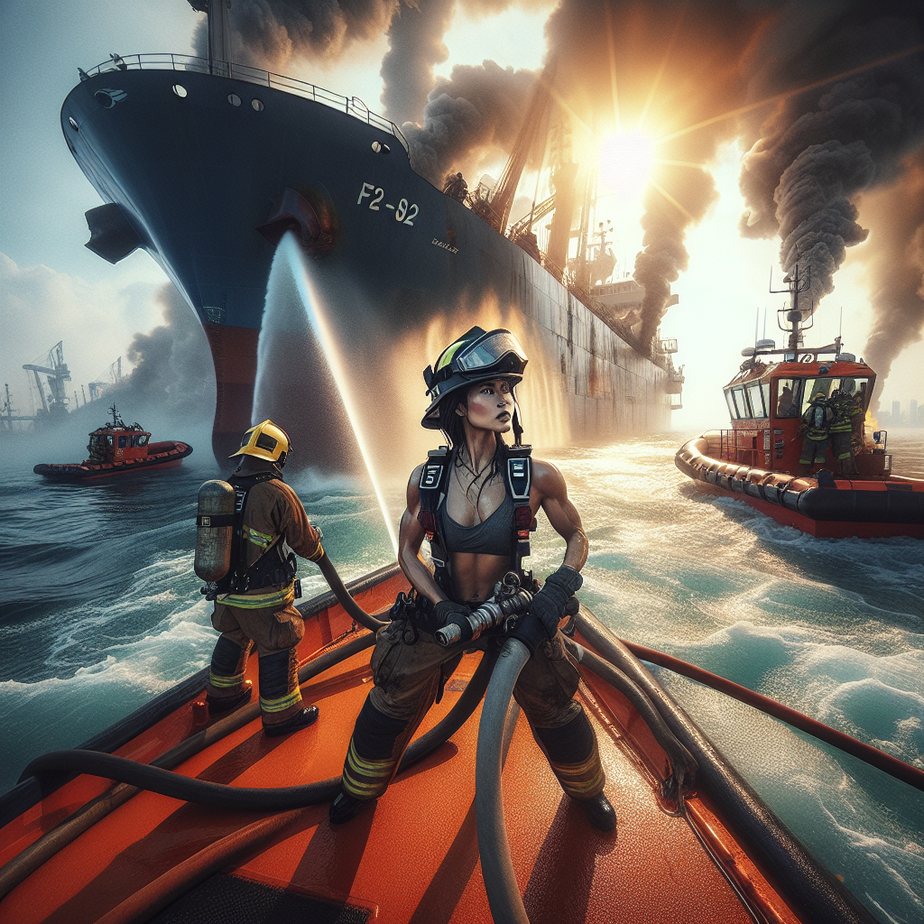Essential Strategies and Best Practices for Effective Marine Firefighting 🚒🔥🌊
Marine firefighting isn’t like your average backyard BBQ disaster—it’s a whole different beast. When flames meet water, things get tricky fast. Unlike a structure fire, where you have solid ground beneath your boots, firefighting on a vessel means dealing with cramped spaces, unpredictable fire behavior, and, let’s be honest, a pretty bad place to have a fire in the first place.
So, grab your firefighting gear (or at least your curiosity), and let’s deep dive (pun intended) into the essential strategies and best practices for keeping flames under control at sea.
1️⃣ Understanding the Unique Challenges of Marine Fires
Imagine this: You’re in the middle of the ocean, and suddenly the smell of smoke fills the air. No nearby fire station. No quick escape. Just you, your crew, and your training. Fighting marine fires requires a whole new skill set because of these challenges:
🚢 Limited Escape Routes – On land, you can run out of a burning building. On a vessel, the only way off is into a whole lot of water. Jumping overboard is rarely a good option.
🎭 Smoke Confinement – Ships are designed to be airtight to stay afloat. But that works against you when smoke has nowhere to go, creating a blinding hazard in tight corridors.
🌊 The Moving Battlefield – Ever tried balancing during rough seas? Now imagine doing that while hauling hoses, wearing full gear, and dodging flames. Not exactly easy.
⚙️ Mechanical & Fuel Risks – Vessels have engines, electrical systems, and a whole lot of fuel. Any fire can quickly escalate into an explosion if not handled properly.
🧯 Water Supply Issues – Sure, you’re surrounded by water, but that doesn’t mean you can use it effectively. Many shipboard fires require specialized extinguishing methods.
2️⃣ Specialized Fire Suppression Techniques for Marine Fires
Unlike land-based fires where hydrants and fire trucks do most of the work, marine firefighting is all about adaptability and precision.
🔥 CO2 Suppression Systems – Many vessels use CO2 flooding systems in engine rooms. These work great, but only if everyone evacuates first—breathing CO2 is not on anyone’s bucket list.
💨 Foam and Dry Chemical Agents – Flammable liquid fires (common in engine rooms) need foam or special dry chemicals—water just spreads the mess.
🚿 Water Fogging Systems – Instead of blasting solid streams of water, fogging reduces heat and smoke, making it safer to navigate through burning compartments.
🤿 Self-Contained Breathing Apparatus (SCBA) – Firefighters must have SCBA tanks screwed on tight since confined smoke can turn a room into a deathtrap within seconds.
🛠 Compartmentalization – Closing doors and sealing off sections of the ship keeps flames from spreading. A well-executed fire boundary can mean the difference between containment and catastrophe.
3️⃣ Quick Response Firefighting Tactics in Marine Environments
If a fire breaks out on a vessel, there’s no time for lengthy response plans. Things escalate within minutes, so every second counts.
🚨 Early Detection – Modern ships have fire suppression systems, heat sensors, and alarms. The key? React the moment that alarm rings—ignoring it for even a few minutes can turn a small issue into a Titanic-scale disaster.
🪖 Fire Teams on Deck – Ships often have trained firefighting squads responsible for handling incidents before external help arrives. Their job is to contain and manage fires so the entire crew doesn’t have to abandon ship.
💡 Power Shutdowns – When electrical fires occur, killing the power supply helps prevent fire from spreading through faulty wiring—because no one wants an unexpected shock while putting out flames.
🚪 Ventilation Control – Oxygen fuels fires. Controlling shipboard ventilation ensures that flames don’t keep growing. If it’s a closed fire, sealing compartments can help smother it.
🆘 Coordination with Emergency Services – If the fire is too big to handle alone, calling in a marine firefighting unit or coast guard assistance is critical. However, in remote waters, the best trained crew usually becomes the last line of defense.
4️⃣ Essential Equipment for Marine Firefighting
Fighting fires at sea requires more than just a trusty fire extinguisher. These essential tools can mean the difference between survival and disaster:
🚒 Fire Pumps – These draw seawater to battle major fires when normal firefighting systems need reinforcement.
🧯 Portable Extinguishers – Different extinguishers are needed for different types of fires (water isn’t always your friend, especially with fuel-based blazes).
🥽 Fire-Proof Gear – Standard turnouts don’t always cut it for marine fires. The best gear can handle extreme heat, high humidity, and potential chemical exposure.
🎙 Two-Way Radios – Large vessels mean large distances between fire teams. Instant communication keeps response teams efficient and safe.
🔥 Thermal Imaging Cameras – Spotting hidden fires behind walls and bulkheads makes it easier to understand where the real danger lies.
5️⃣ Prevention: The Captain’s Best Friend
The best firefight is the one that never happens. Prevention is everything when it comes to keeping ships and crews safe.
⚠ Routine Fire Drills – Practicing evacuation and fire response ensures that, when disaster strikes, panic doesn’t take over.
👷 Proper Equipment Maintenance – Ships have complex machinery, and a single wiring problem can start an inferno. Regular inspections prevent fires before they begin.
🚫 Safe Storage of Flammable Materials – Loose fuel containers or improperly stored chemicals? That’s basically asking for trouble.
🦺 Crew Fire Safety Training – Every crew member, from the captain to the cook, must be fire-prepared. Knowing how to handle extinguishers, alarms, and shutdown procedures is crucial.
🔧 Ventilation and Exhaust Checks – Clogged ducts, excessive grease, or blocked exhaust outlets turn kitchens and engine rooms into potential fire zones. A clean ship is a safer ship.
Final Thought: Fire, Water, and Quick Thinking 🌊🔥
Fighting fires on land is one thing, but handling them at sea? That’s an entirely different game. Marine firefighters operate in confined, moving, and often unpredictable environments where one wrong move can mean the loss of the entire vessel. By understanding fire behavior, using the right suppression techniques, and practicing solid prevention strategies, crews can keep their ships (and themselves) safe.
Because at the end of the day, fire and water make for a dangerous mix—unless you know how to fight back. 🚒💪
What are your thoughts on marine firefighting? Have you ever been in a fire emergency at sea? Share your experiences in the comments below! 🚢🔥👇



